| |
We learned Vて forms in Lesson 10. (Review the Grammar Notes here.) The combination of Vて + います describes an action in progress or repeated actions
(similar to "be V-ing" in English). The following chart
shows the conjugation of Vています.
| |
| Affirmative |
Vて |
います |
Vて |
いました |
| Negative |
Vて |
いません |
Vて |
いませんでした |
For example:
|
| Affirmative |
たべています |
たべていました |
| is eating |
was eating |
| Negative |
たべていません |
たべていませんでした |
| is not eating |
was not eating |
More examples:
| |
|
|
| (今)
日本ごを |
べんきょうしています。 |
I am studying Japanese (now). |
ソニーで
|
はたらいています。
|
(He) is working at Sony. |
| スミスさんは ともだちと |
はなしています。 |
Smith is
talking with her friends. |
| 田中さんは うちで てがみを |
かいていました。 |
Tanaka was
writing a letter at home. |
| まいにち、インターネットを |
つかっています。 |
I'm using the Internet
everyday.
[repeated action] |
| うちで ペットを |
かっています。
(かう: to keep [pets];
not the same verb as かう: buy
) |
I am keeping a pet at home. |
|
| |
As you already know, not every sentence in Japanese requires the
subject such as わたし or ぼく. If the subject is understood from the
context, it is naturally dropped from the sentence. This does not
mean that person pronouns are unimportant in Japanese. In fact,
Japanese has an elaborate system of person pronouns, and they are
chosen according to various factors---how close the speaker is toward
the listener in terms of social ranking or intimacy, or how polite and/or formal the speaker would like
to be, etc.
|
| 私 {わたし, わたくし [formal]} |
I, me (generic) |
| ぼく |
I, me (male) |
| おれ |
I, me [blunt] (male) |
| 私たち |
we, us (generic) |
| ぼくたち |
we, us (male) |
|
| あなた |
you (toward a peer or subordinate
person) |
| きみ |
you (toward a peer or subordinate
person) |
| おまえ |
you [blunt] (toward a peer or subordinate
person) |
|
| かれ |
he |
| かれら |
they (generic) |
| かのじょ |
she |
| かのじょたち |
they (female) |
If you are a beginner of Japanese, it is best to avoid using any of the second person pronouns. The second person pronouns are used in limited situations and ONLY when you are talking to someone with an equal or lower ranking in terms of age, social status, etc. Names (e.g., 田中さん, ケントくん, etc.) are used far more commonly than person pronouns. It is extremely offensive to use them when you are speaking with strangers or someone with a higher social ranking. See the culture notes. |
| |
Another function of the Vています form is to express a state
resulting from a completed action or event. Instead of "V-ing,"
this translates to "Something has V-ed." Verbs used in
this interpretation refer to a change of state (e.g., けっこんする "to get married" --- change from "single"
to "married").
With the verb けっこんする ("to get married") or りこんする ("to get divorced"), the
following expressions are possible.
けっこんします。
りこんします。 |
future action |
I am going to get married.
I am going to get divorced. |
けっこんしません。
りこんしません。 |
future action |
I am not going to get married.
I am not going to get divorced. |
けっこんしました。
りこんしました。 |
past action |
I got married.
I got divorced. |
けっこんしませんでした。
りこんしませんでした。 |
past action |
I did not get married.
I did not get divorced. |
けっこんしています。
りこんしています。 |
present state |
I am married.
I am divorced. |
けっこんしていません。
りこんしていません。 |
present state |
I am not married.
I am not divorced. |
けっこんしていました。
りこんしていました。 |
past state |
I had been married. / I was
married.
I had been divorced. / I was divorced. |
けっこんしていませんでした。
りこんしていませんでした。 |
past state |
I had not been married. / I was
not married.
I had not been divorced. / I was not divorced. |
If 今(いま) is used, the verb ending must be ています as in 10年まえに けっこんしましたが、今は りこんしています.
Compare the following expressions using やせる (る-verb: to lose weight) and ふとる (う-verb: to gain weight).
Other expressions that use the resultant state verbs are shown below. Be careful with the verbs つとめる and はたらく below. They take different particles --- に and で, respectively.
| 先生は ふるい くるまを もって います。 |
The teacher has an old car.
(has changed from "no car" to "has a car") |
| 私はかぜを ひいています。 |
I have a cold.
(かぜを ひく: to catch a cold;
have changed from "healthy" to "sick") |
ソニーに つとめています。
ソニーで はたらいています。 |
(He) is working for Sony.
(He) is working at Sony. |
| すずきさんはアトランタに すんでいます。 |
Ms. Suzuki lives in Atlanta. |
The Vています form of motion verbs (e.g., いきます, きます,
かえります, でます, でかけます) describes a state resulting from "coming"
and "going." (Note: For the verb いく, it can express
a repeated action of "going somewhere (every day)".)
 いっています いっています
is going (every day)
or
went and is there now |
まいにち、がっこうに いっています。
I'm attending school every day. [repeated actions] |
すず木さんの お父さんは ちゅうごくに いっています。
Mr. Suzuki's father has gone to China. |
 きています きています
came and is here now |
ともだちが日本から きています。
A friend has come from Japan (and she is still here). |
 かえっています かえっています
returned and is at home now |
田中さんの お兄さんは うちに かえっています。
Ms. Tanaka's older brother has returned home (and he is at home). |
 でています でています
went out and is out now |
大学を でています。
I have graduated from a college. |
あたらしい えいがが でています。
A new movie is out. |
 でかけています でかけています
went out and is out now |
いもうとは スーパーへ でかけています。
My younger sister has gone out to the supermarket. |
 いんたいしています いんたいしています
retired and is not working now
|
父はがっこうの先生でしたが、今は いんたいしています。
My father was a school teacher, but he is now retired. |
|
| |
Earlier, we learned the particle と (e.g., NとN) can be used to combine nouns. However, と cannot combine phrases or sentences (i.e., あさ、おきました と、 シャワーを あびました is ungrammatical). Instead, we use て forms to combine two or more phrases or sentences. The て-form of い-adjectives ends with くて (Delete い and add くて: たかい → たかくて) and the て-form of な-adjectives and nouns are ~で (e.g., べんりで and 先生で). Caution: When combining phrases with a て-form, the two phrases need to be compatible or semantically not opposite of one another.
| |
|
| V |
|
|
|
|
| ひるごはんを |
かって |
きます。 |
I will go and buy lunch.
(Lit. "I will come back having lunch.") |
| 田中さんは、 |
おきて |
シャワーを あびました。 |
Mr. Tanaka woke up and took shower. |
| 私はタイから |
きて |
日本に すんでいます。 |
I came from Thai and live in Japan. |
| い-Adj |
そのたてものは |
ふるくて |
ゆうめいです。 |
The building is old and famous. |
| そのアパートは |
ちいさくて |
べんりでした。 |
The apartment was small and convenient. |
| な-Adj |
私のへやは |
しずかで |
あかるいです。 |
My room was quiet and bright. |
| 私は おんがくが |
すきで |
よく うたを うたいます。 |
I like music and sing songs often. |
| N |
これは |
千円で |
あれは二千円です。 |
This is 1000-yen and that is 2000-yen. |
| スミスさんは |
大学生で |
日本ごを
べんきょうしています。 |
Mr. Smith is a college student
and is studying Japanese. |
| せんこうは |
アジア
けんきゅうで |
中ごくについて
べんきょうしています。 |
My major is Asian Studies
and I am studying on China. |
|
| |
とき is a noun referring to "time." The structures /Nの とき/ or /い-Adj とき/ or /な-Adjな とき/ can be used
to refer to the time when something happens.
| |
| 25さいの |
とき |
けっこんしました。 |
At the age of 25, I got married. |
| こどもの |
とき |
よく 本を よみました。 |
When I was a child, I often read
books. |
| ひまな |
とき |
えいがに いきませんか。 |
When you are not busy, won't you
go to a movie? |
| いそがしい |
ときは |
たべません。 |
When I'm busy (at least), I don't
eat. |
|
 |
| |
When referring to one's own family members while speaking to an
outgroup person, we use humble terms ( )
as shown below. )
as shown below.
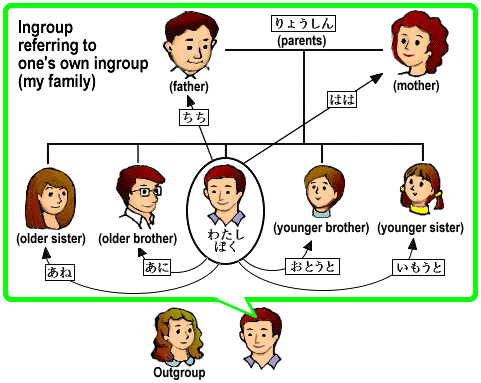
When referring to the members of another's family (outgroup), we
use honorific terms ( )
as shown below. Given names or nicknames are used to refer to someone
younger than the speaker. The title くん (for young males) or ちゃん
(a child form of さん, often used for young females) is often used with the names. )
as shown below. Given names or nicknames are used to refer to someone
younger than the speaker. The title くん (for young males) or ちゃん
(a child form of さん, often used for young females) is often used with the names.
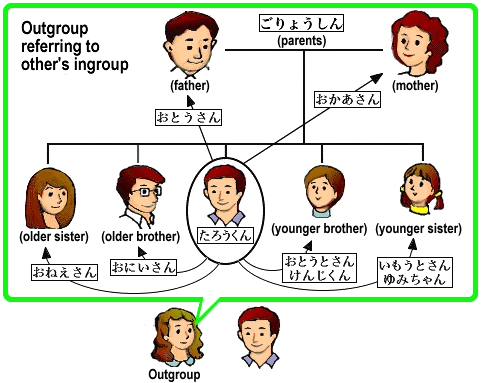
|
When you address your own family members directly,
we use the honorific terms ( ) for the older members, ) for the older members,
and their first names for the younger
ones.
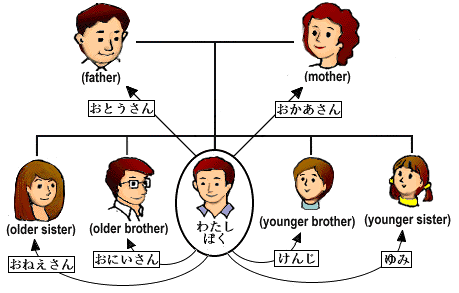
|
 |

FYI: One's spouses can be referred to by other generic terms
such as おっと ("husband") and つま ("wife").
おっと and つま are less commonly used.
boy(s): 男の子; girl(s): 女の子
|
The following are examples of describing family members.
- 姉 {あね} は はたちで、大学二年生です。
"My older sister is 20 years old and is a sophomore in college."
- 父 {ちち} は 48さいで、IBMにつとめていて、母 {はは} は40で、じえいぎょうを しています。
"My father is 48, is working for IBM, and my mother is 40 and is self-employed."
- そふは ぎんこういんでしたが、5年まえに いんたいして、今は はたらいていません。
"My grandfather was a banker, but he retired 5 years ago and now he is not working."
|
| |
To count people, the counter 人 (pronounced り or にん)
is used. り is used for up to two people. To count more than
two people, use the counter にん as shown below.
1 |
一人 {ひとり} |
one person |
2 |
二人 {ふたり} |
two persons |
3 |
三人 {さんにん} |
three persons |
4 |
四人 {よにん} |
four persons |
5 |
五人 {ごにん} |
five persons |
6 |
六人 {ろくにん} |
six persons |
7 |
七人 {しちにん
or ななにん} |
seven persons |
8 |
八人 {はちにん} |
eight persons |
9 |
九人 {きゅうにん} |
nine persons |
10 |
十人 {じゅうにん} |
ten persons |
? |
何人 {なんにん} |
How many people? |
|
To say you have a certain number of family members (ingroup), you
can use the following pattern. Either います or あります verb can be used for this particular situation.
| |
| 私は |
兄 {あに} が |
二人 |
います。
あります。 |
I have two older brothers. |
To state the order of siblings, we use 番目{ばんめ} counter: 一番目, 二番目, 三番目, etc. The question word is 何番目{なんばんめ} ("What N-th?"). In general, the suffix 目(め) can be attached any counter and create an ordinal number (e.g., 三人目 = third person; 二こ目 = second small, solid thing; 四時間目 = 4th hour, 三さつ目 = third book, 七本目 = 7th long, cylindrical object, 一まい目 = first thin, flat object, etc.).
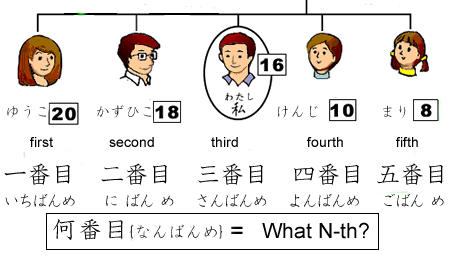
|
私は 兄弟 {きょうだい} が 四人います。
|
I have four siblings. |
| 一番上 {いちばんうえ} は 姉 {あね} のゆうこです。 |
The oldest is my older sister, Yuko. |
| 二番目は 兄 {あに} のかずひこです。 |
The second is my older brother, Kazuhiko. |
| 私は 上から三番目です。 |
I am the third from the top. |
それから、弟 {おとうと} のけんじと
妹 {いもうと} のまりが います。 |
And, I have a younger brother, Kenji and a younger sister, Mari. |
|
| |
To count people's (or animal's) age, we use the つ counter (1-10 years old) or the さい counter (any age).
1 |
一つ {ひとつ} |
一さい {いっさい} |
one year old |
2 |
二つ {ふたつ} |
二さい {にさい} |
two years old |
3 |
三つ {みっつ} |
三さい {さんさい} |
three years old |
4 |
四つ {よっつ} |
四さい {よんさい} |
four years old |
5 |
五つ {いつつ} |
五さい {ごさい} |
five years old |
6 |
六つ {むっつ} |
六さい {ろくさい} |
six years old |
7 |
七つ {ななつ} |
七さい {ななさい} |
seven years old |
8 |
八つ {やっつ} |
八さい {はっさい} |
eight years old |
9 |
九つ {ここのつ} |
九さい {きゅうさい} |
nine years old |
10 |
十 {とお} |
十さい {じゅっさい} |
ten years old |
20 |
|
はたち |
twenty years old |
? |
いくつ |
何さい |
How old?
How many years old? |
|
| |
A typical introduction of one's own family members (ingroup) involves
the family term and their names. You refer to your own members with これ  ("this here"). これ is considered humble in this case. In contrast, こちら ("this here"). これ is considered humble in this case. In contrast, こちら , そちら , そちら , あちら , あちら are used to refer to other's family members. These demonstrative nouns are considered honorific. are used to refer to other's family members. These demonstrative nouns are considered honorific.
You can also use the expression うち ("my house"). うちの is equivalent to the English
expression "my..." (Lit. "my house's"). ("my house"). うちの is equivalent to the English
expression "my..." (Lit. "my house's").
| |
| これは |
うちの |
母です。 |
This is my mother. |
| これは |
うちの |
こです or こどもです。 |
This is our child. |
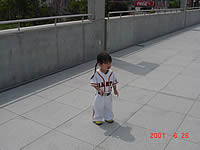 |
|
The same caution applies to talking about one's own family members.
お父さん は
どのぐらい アメリカに いますか。 は
どのぐらい アメリカに いますか。 |
How long has your
father
been in the U.S.? |
お父さん は
どのぐらい アメリカに いらっしゃいます は
どのぐらい アメリカに いらっしゃいます か。 か。 |
父 は
5年ぐらい アメリカに います。 は
5年ぐらい アメリカに います。 |
My father has been
in the U.S.
for 5 years. |
 いらっしゃいます is an honorific form of the verb います. NEVER use honorific verbs for your own family members. 父は アメリカに いらっしゃいます is completely unacceptable. いらっしゃいます is an honorific form of the verb います. NEVER use honorific verbs for your own family members. 父は アメリカに いらっしゃいます is completely unacceptable.
 It is a mistake to use the outgroup family term (e.g., お父さん) used
by outgroup members when you refer to your own family members. Be
sure to use the ingroup term (e.g., 父). It is a mistake to use the outgroup family term (e.g., お父さん) used
by outgroup members when you refer to your own family members. Be
sure to use the ingroup term (e.g., 父).
When you introduce others' family members (outgroup) to someone,
you refer to them with こちら  ("this here"). こちら is considered an honorific term in this case. ("this here"). こちら is considered an honorific term in this case.
Out-Group Introduction
| |
| こちらは |
いもうとさんの |
けいこさんです。 |
This is his/her
younger sister Keiko. |
| こちらは |
お父さんの |
よしおさんです。 |
This is his/her
father Yoshio. |
| こちらは |
むすめさんの |
まりさんです。 |
This is his/her
daughter Mari. |
| こちらは |
おくさんの |
ゆうこさんです。 |
This is his wife Yuko. |
| こちらは |
ごしゅじんの |
けんいちさんです。 |
This is her husband Ken'ichi. |
You can also use the following expression to introduce others'
family members.
| |
| こちらは |
田中さんの |
お母さんです。 |
This is Ms. Tanaka's mother. |
Note: If the person to be introduced is not nearby the speaker,
other demonstratives (それ , あれ , あれ or そちら or そちら , あちら , あちら )
can be used. )
can be used. |
|
| |
The clothing verbs are as follows:
- きる or きます [る-verb]: to wear on the upper body (suit, shirt, etc.)
- はく or はきます [う-verb]: to wear on the lower body (pants, skirts, shoes)
- かぶる or かぶります [う-verb]: to wear on the head (hat)
- かける or かけます [る-verb]: to wear by hanging (primarily for glasses)
- する or します: to wear by attaching (necktie, scarf, ribbon, glasses, wrist watch, earrigns, rings, etc.)
- もつ or もちます: to have/hold/carry (a bag)
The resultant state Vています form needs to be used to describe what people are currently wearing as follows. Note that we use different clothing verbs for different clothes.
| |
|
| まりさんは |
スカートを |
はいて |
います。 |
Mari is wearing a skirt. |
| ブラウンさんは |
くろいくつを |
はいて |
います。 |
Mr. Brown is wearing black shoes. |
| スミスさんは |
めがねを |
かけて |
います。 |
Mr. Smith is wearing glasses. |
| よしだ先生は |
ネクタイを |
して |
います。 |
Prof. Yoshida is wearing a necktie. |
| 田中さんは |
ぼうしを |
かぶって |
います。 |
Ms. Tanaka is wearing a hat. |
| きむらさんは |
スーツを |
きて |
います。 |
Mr. Kimura is wearing a suit. |
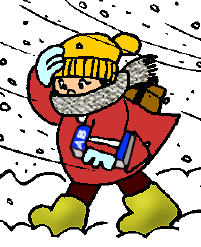 |
コートを
|
きています。 |
She is wearing a coat. |
てぶくろを
マフラーを |
しています。
しています。 |
She is wearing gloves.
She is wearing a scarf. |
| ぼうしを |
かぶっています。 |
She is wearing a hat. |
| ズボンを |
はいています。 |
She is wearing pants. |
| 本を |
もっています。 |
She is holding a book. |
| ブーツを |
はいています。 |
She is wearing boots. |
|
| |
The following are body part terms for describing people's physical appearances and additional adjectives and nouns.
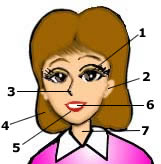
1: 目{め} (eye)
2: 耳 {みみ} (ear)
3: はな (nose)
4: かみ (hair)
5: 口 {くち} (mouth)
6: は /ha/ (teeth)
7: くび (neck) |
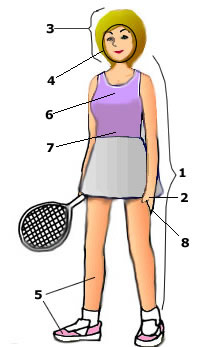 |
1: からだ (body)
2: 手 {て} (hand/arm)
3: あたま (head)
4: かお (face)
5: 足 {あし} (leg/foot)
6: むね (chest)
7: おなか (stomach)
8: ゆび (finger/thumb/toe)
9: せ (height of a person) |

round
|
まる (n) or
まるい (い-adj) |

slender,
skinny,
wiry |
ほそい (い-adj)
|

long
|
ながい (い-adj) |

long & skinny |
ほそながい (い-adj) |

rectangular
|
しかく (n) or
しかくい (い-adj) |

thick |
ふとい (い-adj)
|

short
|
みじかい (い-adj) |
 
tall vs. short |
せがたかい (い-adj)
vs.
せがひくい (い-adj) |
| |
あか (n)
あかい (い-adj) |
|
みどり (n)
グリーン (n) |
|
しろ (n)
しろい (い-adj) |
| |
あお (n)
あおい (い-adj) |
|
ちゃいろ (n)
ちゃいろい (い-adj) |
|
はいいろ (n)
グレー (n) |
| |
きいろ (n)
きいろい (い-adj) |
|
オレンジ (n) |
|
くろ (n)
くろい (い-adj) |
~は~が structure is used to describe physical appearances of something or someone. This is often translated as "Someone has ..." or "Someone's ... is/are ..." as shown below. To combine two expressions, て form is used.
| |
|
| まりさんは |
せが
かみが |
ひくいです/たかいです。
みじかいです。 |
Mari is short / tall.
Mari's hair is short. (= has short hair.) |
| 田中さんは |
目{め} が
口 {くち} が |
大きいです。
小さいです。 |
Tanaka's eyes are big. (= has big eyes)
Tanaka's mouth is small. |
| 田中さんは |
目が大きくて、口が小さいです。 |
Tanaka's eyes are big and her mouth is small. |
| きむらさんは |
足 {あし} が
手 {て} が |
ほそいです。
ふといです。 |
Kimura's legs are skinny. (= has skinny legs)
Kimura's arms are thick. |
| きむらさんは |
足がほそくて、手がふといです。 |
Kimura legs are skinny and her arms are thick. |
| おかださんは |
かおが |
まるいです。
しかくいです。
ほそながいです。
きれいです。 |
Okada's face is round. (= has a round face)
Okada's face is shaped like a rectangular.
Okada's face is long and narrow.
Okada's face is pretty. |
| おかださんは |
かおがまるくて、きれいです。 |
Okada's face is round and pretty. |
| スミスさんは |
かみが
|
くろいです。
ちゃいろいです。
きんぱつです。
ながいです。
みじかいです。
|
Smith's hair is black. (= has black hair)
Smith's hair is brown.
Smith's hair is blonde.
Smith's hair is long.
Smith's hair is short. |
| スミスさんは |
かみが
目が
日本ごが
|
きんぱつです。
あおいです。
じょうずです。 |
Smith's hair is blonde. (= has blond hair)
Smith's eyes are blue.
Smith is good at Japanese. |
| スミスさんは |
かみがきんぱつで、目があおくて、
日本ごがじょうずです。 |
Smith's hair is blonde, eyes are blue
and her Japanese is good. |
If the expressions being combined are opposite in nature (e.g., positive vs. negative), けど or が connective is more likely to be used.
- あのスーパーはあたらしくて、大きいです。(Both positive values: "new and big")
- あのスーパーはあたらしいですけど、小さいです。(Positive and negative values: "new but small")
- あのスーパーはやさいがきれいで、やすいです。(Both positive values: "pretty/clean and cheap")
- あのスーパーはやさいがきれいですが、たかいです。(Positive and negative values: "pretty/clean but expensive")
The expressions shown above can be stated in separate sentences by using それに ("furthermore"), そして ("and"). When combining them with それに or そして, make sure they are not opposite in nature. If the descriptions are opposite in nature, use けど、が、or でも instead.
- スミスさんは、かみが ながくて、目{め} が 大きいです。
⇒ スミスさんは、かみが ながいです。それに (or そして)、目が 大きいです。
- 山田さんは、せが ひくくて、足 {あし} が ふといです。
⇒ 山田さんは、せが ひくいですけど、足 {あし} は ふといです。
⇒ 山田さんは、せが ひくいです。でも、足は ふといです。
|
| |
We have seen so far that a noun can be modified by another noun (田中さんのくるま "Mr. Tanaka's car") or an adjective (ふるい本 "old book"). A noun can also be modified by a clause (or a sentence within a sentence). This structure is called a "modifying clause" which is similar to a relative clause in English. A modifying clause is required to be in the plain form.
If the modifying clause ends with a plain, non-past affirmative copula だ (e.g., テニスが じょうずだ and かみが きんぱつだ), だ changes to な for な-adjective sentences (See ◆ below), and だ changes to の for noun sentences (See ● below).
|
|
|
|
| Verb |
ぼうしを かぶっている |
女の人 |
the woman who is wearing a hat |
| Verb |
でんわをしている |
人 |
the person who is on the phone |
| Verb |
田中さんがみている |
ニュース |
the news (that) Ms. Tanaka is watching |
| Verb |
田中さんがはなしている |
人 |
the person with ★ whom Mr. Tanaka is talking |
| い-Adj |
かみが ながい |
女の人 |
the woman whose hair is long |
| な-Adj |
テニスが じょうずな◆ |
人 |
the person who is good at tennis |
| な-Adj |
ぜんぜん しずかじゃない |
へや |
the room that is not quiet at all |
| Noun |
せんこうが ぶんがくの● |
がくせい |
the student whose major is literature |
| Noun |
かみが きんぱつの● |
女の人 |
the woman whose hair is blonde |
The English translations of these structures often require a relative pronoun (e.g., that, in which, who, where, etc.). Note that the Japanese structures do not have a relative pronoun, and the particles associated with the modified noun (e.g., と "with" marked by ★ above) are dropped entirely while the English translation retains these particles.
The subject marker が within a modifying clause can be replaced by the particle の.
| かみのくろい |
男の人 |
the man whose hair is dark |
The /modifying clause + N/ pattern is a recurring pattern in Japanese, so it is worth investing time to practice it. For example, it can be used as a topic of the sentence:
Topic |
Comment |
| Modifying Clause + N |
P |
|
| あの かみの ながい 女の人 |
は |
田中さんです。 |
| The woman whose hair is long |
|
is Ms.Tanaka. |
The modifying part of the sentence can be long and complex. The modifying clause below contains two adjectives combined with a て-form ("and") in addition to the prenominal あの in front.
| Q: |
あの、せが たかくて、うたが じょうずな人は だれですか。
"Who is that person who is tall and good at singing?" |
| A: |
ああ、あの人はブラウンさんですよ。 |
Earlier, we learned the /Plain-Present V + の/ structure (e.g., およぐのが すきです "I like swimming."). This is essentially a clause modifier structure with a clause modifier (およぐ) followed by a noun (の). You can see this easily once we start expanding the verb: ともだちと うみで およぐのが すきです ("I like swimming in the ocean with my friends."). |
|
|